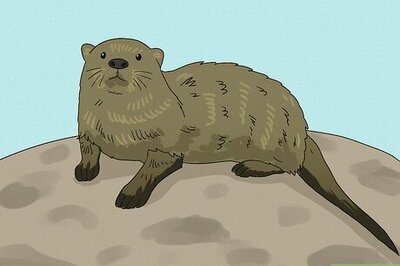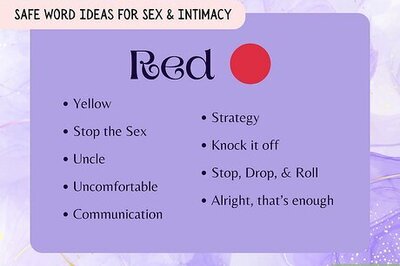
views
The flora and fauna, bathed in a riot of colours nearly spills over the edges of the painting, as your fascinated gaze takes in Madhubani artist, Anuradha Upadhyay’s depiction of the Radha and Krishna theme. With eyes boldly outlined, a multi-coloured flute or a bejewelled Radha juxtaposed with Krishna, the painting is awash with colour.
There is also a colourful Lord Ganesh and Devi Durga surrounded by fantastic flowers while another panel depicts ‘ardhanariswara’ brilliantly conceived in the folk style.
Madhubani, meaning ‘Forest of Honey’ art is also known as Mithila painting belongs to Bihar and is thoroughly rooted to tradition.
‘’Observing and absorbing from the work of women in the family, this art has become an intrinsic part of my life since childhood,’’ reminisces this native of Bihar. The artist is showcasing some of her interesting creations in the art form at an exhibition - Anukriti - at the Rashtriya Lalit Kala Akademi here.
Anuradha paints a profusion of flowers, leafy trees and animals in vibrant vegetable colours. Bright oranges, auspicious yellows, shades of green, deep red and blue vie for attention, but never appear garish. The human figures in her works have typically elongated eyes, and possess the magic of folk fantasy while the animals have a peculiar dynamism and movement.
However, it’s not just Madhubani that dominates her oeuvre. Equally beautiful are her Warli and Pattachitra paintings which she has juxtaposed with Dhenkanal’s Dokra craft. ‘’Anukriti is a collection of art work created over last one year. It entails experiments with Warli paintings, Pattachitra besides Madhubani paintings and few fusion work involving handmade paper, palm leaf, Dokra, crab shells and sand art,’’ says the self-taught artist from Mumbai.
Speaking about her Odia connection, Anuradha says: ‘’My parents belong to Bihar, but I was born in Bhubaneswar and at present, I stay in Maharashtra. So I was fortunate enough to have been able to pick up the art forms of all the three states. At present, I am learning Pattachitra.”
Warli, according to her, is the name of the largest tribe found on the northern outskirts of Mumbai. ‘’Warli comes from the word ‘warla’, which means a piece of land,’’ she explains, adding that Warli art is a vivid expression of the daily and social events of the tribe whose members used their skills to decorate walls of their houses.
She says her series on Warli folk paintings are a vibrant celebration of the substance and fabric of life. Many of her creations in the form typically depict multitudes of tiny human forms hunting, dancing or cultivating the land against a backdrop of tribal huts and all of them are done on mustard yellow, green, red, orange and white backgrounds. The sheer joy of life comes through in paintings which depict the typically line-drawn stylised figures as they sing, dance, draw water or till their fields in circular formations or in beautifully harmonised compositions and silhouettes. Her fusion of ‘Dokra’ metal figures with Warli art frames are innovative. The black and white Warli art frames offer a perfect counter-poise to the primal dancing figures. Among the works on display are rural scenes, depiction of a village, the dance of peacock, Dussehra festivities, a tribal playing a musical instrument, and one with women and palm trees.
She does the paintings both on cloth, canvas and paper. Anuradha has also created interesting folk themes on crab shells. The exhibition is on till Friday evening.
















Comments
0 comment